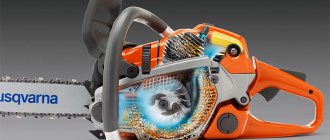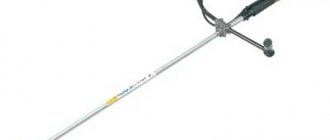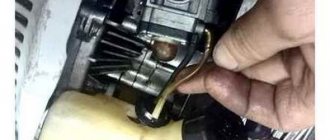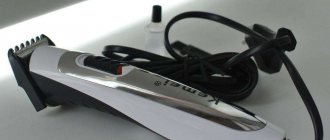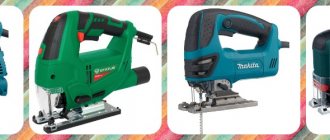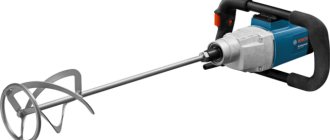Neatly trimmed green lawns, a smooth lawn - the fashion for such design of a personal plot came to us from the West. Unfortunately, due to the hilly terrain, the lawn mowers necessary to care for such beauty did not take root. Trimmers and lawn mowers instantly took their place and are now an integral part of any private home or cottage.
When thinking about buying a modern scythe with a motor, you begin to compare different models, look for benefits and disadvantages in order to choose the best option. On your way you come across both trimmers and brush cutters, and here the questions arise: “What is the difference between them?” and “Which device is better?” To get the answer, let's first talk about each tool separately.
Motor trimmer, brush cutter, trimmer - what are their differences?
When cleaning adjacent areas in the city and beyond, in private sector cottages, the need arises to use garden tools.
One of the types of garden tools are trimmers or brush cutters. What is the difference between them? In fact, these two types of devices are not much different from each other. Trimmers are used for mowing grass thickets, even in the most difficult conditions. Many areas that are extremely difficult to reach are quite difficult to treat with a regular lawn mower. And the proposed unit copes with this task in the best possible way.
In many garden supply stores, a trimmer and a brush cutter are considered the same tool.
Conclusion - which is better?
It is impossible to say unequivocally what is better to use - a trimmer or a brush cutter. After all, the difference between them lies in their purpose, and, accordingly, in technical and operational parameters. For a small garden plot or cottage, you should choose a trimmer, and electric models are much cheaper to operate . True, you won’t be able to trim trees and bushes with its help, but it is safer and more convenient. And if you need to improve a large plot of land and perform a variety of work on it, including crowning trees, pruning bushes and vegetable fences, then a powerful brush cutter with various attachments included is suitable.
Differences between a trimmer and a lawn mower
If the seller knows what is the difference between a lawn mower and a trimmer, he will not be able to get a definite answer. Some will say that there is no difference between these types of garden tools. Another store will explain that the different part is where the engine is located. For a trimmer it is located at the bottom of the device, for a brush cutter it is located at the top. In addition, the engine in them is either electric or runs on gasoline. There are assumptions that the difference is in the available cutting elements. How can a trimmer actually differ from a braid, and we need to understand it in more detail.
When it is necessary to trim overgrown grass or small shrubs, the best option is a trimmer. Getting an evenly trimmed surface with such a tool is much more difficult than with a regular lawn mower. For trimming hard-to-reach areas: near trees, the edges of lawns, under curbs or fences, in areas where large unevenness or slopes are visible, the trimmer will be indispensable. This is the most important and most significant difference between this device and a lawn mower.
A gas trimmer is a type of trimmer that has more power and is more productive thanks to the built-in engine running on gasoline. This unit is best used in areas with a large area, when the main thing is to cut the grass, without taking into account the aesthetics of the work. The lawn mower is used to combat dense thickets, bushes and young shoots of trees. These differences are considered general; in order for the selected tool to fully meet expectations, you need to read the technical characteristics of the model of interest in more detail.
Differences between the two devices
The main difference between these devices is their configuration.:
- the brush cutter is equipped with a knife or saw blade;
- trimmer with trimmer head only.
If the device only includes a head, it is a trimmer, but if in addition to it there is any other cutting tool, it is a brush cutter (petrol mower). The same rule applies to electric or battery-powered devices.
However, Wikipedia describes another point of view, which states that a trimmer is a manual electric corded or battery-powered lawn mower with a lower-mounted commutator electric motor (above the working head) of low power.
A special fishing line is used as a cutting element. The trimmer is designed for mowing ordinary grass with thin and soft stems in a small area, as it depends on the length of the mains cable, or on the short duration of operation on a single battery charge.
Trimmer attachments are also used on brush cutters, for mowing grass around trees, along fences, walls (since the use of disc attachments can damage them or be dangerous).
But in our opinion, this point of view does not take into account the historical context of the appearance of this term , and therefore is not correct. However, sometimes store sellers stick to it, so the buyer needs to know what its inventor meant by a “trimmer” in order not to make a mistake when choosing a manual lawn mower.
What to consider when choosing a trimmer or brush cutter
To make the right choice, you need to know for what types of work you are choosing a tool. In addition, have accurate information about the upcoming cleaning of the area in order to answer the following questions:
- What area is to be processed;
- How long will the unit be used?
- Type of vegetation to be removed.
A simple version of the tool with low power can be chosen for a summer house where trees grow and some places under them cannot be processed with a regular lawn mower. A gasoline-powered brushcutter will be chosen by those who have to clean an area of 20 acres or more with dense thickets.
When choosing, you need to focus on:
- The capacity of the engine built into the unit (it determines what kind of growth the unit can handle). In case of frequent use of the tool, preference is given to low-power types. Mowers with more powerful engines can quickly break down if used frequently.
- The type of engine (will the device operate from an electrical network or will it be enough to fill the tank with gasoline);
- Type of cutting tool (nylon cord for thin plants, steel disc for thicker and harder types of vegetation);
- Line feeding mechanism (preference is given to automatic or semi-automatic feeding);
- What is the handle and weight of the entire tool (the best option is a backpack or shoulder);
- Choosing a rod (straight, curved, monoblock, telescopic);
- The grip size (the value must be selected in accordance with the installed motor);
- Battery capacity (if running on batteries);
- Tank capacity (if choosing lawn mowers). You should not choose options with a large tank if a woman will be working, because when mowing lawns, the unit must be held in your hands, regardless of the presence or absence of a shoulder strap. On the contrary, men can choose a more capacious tank so as not to waste time on frequent refueling with gasoline.
All of the above criteria are the main things you should pay attention to when choosing a garden tool. By adhering to all the listed rules when buying a trimmer or brush cutter, you can choose the most suitable garden tool that will help you easily clean up the surrounding area.
Criterias of choice
You need to choose the “right” unit based on your personal needs.
The main advantages of gasoline trimmers are power and mobility.
The beauty of electric tools is their low weight and low maintenance (no need to spend money on gasoline).
When choosing a lawn mower, there are several factors to consider:
- Who will mow the grass? For women, men in poor health, or the elderly, a lightweight electric trimmer is best. It will not overload your back and arms, and frequent stops (to recharge the battery or change the location of wires) will provide additional rest for the body. Strong young men are better suited to a brush cutter with a straight bar. With its help, the work will be completed many times faster.
- How much area needs to be cleared of weeds? For small areas (flower beds, garden paths, etc.) a trimmer is sufficient. A lawn mower will do a better job of cleaning large areas (several tens or hundreds of square meters).
- Are there outlets on site? If there is no free access to electricity in the area, it is better not to choose an electric trimmer. You can, of course, extend several extension cords or choose a cordless model - but using them will be less convenient than using a lawn mower.
- What is the nature of the vegetation on the site? Although manufacturers equip low-power electric trimmers with knives, you shouldn’t place much hope on them. These units are designed for lawn grass and similar plants with thin stems. Using knives (often plastic) you can only cope with thicker weeds or soft branches of bushes. But in very small quantities. For heavily overgrown areas, only a brush cutter is suitable. It is she who will successfully overcome perennial vegetation.
An important point: all such instruments are air cooled. This means that both the electric trimmer and the scythe cannot be operated for a long time at high speeds. To protect against overheating, the engine must be allowed to cool down regularly.
For domestic needs, these selection criteria will be sufficient. It is advisable for professional lawn mowers to pay attention to the engine. It’s worth noting that the competition “scythe vs. trimmer” is no longer relevant here—for professionals, only a brushcutter.
This unit can be equipped with a two-stroke or four-stroke engine. It’s difficult to say which is better; you need to start from the specific situation. The four-stroke type of engine is much more powerful, but such units are twice as heavy (during long-term operation there is a large load on the back).
What is the difference between a trimmer and a lawn mower?
Trimmers are designed for short-term work cutting lawns in hard-to-reach areas and are suitable for soft lawn grass. As a rule, these are structurally simple, low-power devices equipped with an electric motor. There are battery models and models with a gasoline engine.
Petrol mowers, or as they are also called, brush cutters, are designed for more serious, long-term work on mowing grass over large areas. Unlike trimmers, they can work through tough grass, vines, bushes, and even cut down small trees.
Which is better - a gas trimmer or a gas mower?
The trimmer head is included with the vast majority of brush cutters and brush cutters, so devices equipped with an additional cutting tool are more versatile .
In addition, trimmer owners often buy an additional cutting tool for mowing dense or thick vegetation, because the line wears out quickly, so it has to be changed frequently.
You also cannot do without a knife or disk if you have to cut out unwanted growth of trees or shrubs, or trim from a branch. Therefore, a brushcutter or gas mower is the same trimmer, only with wider functionality, suitable not only for mowing the lawn or trimming the grass around trees, but also for performing other work.
What are the key differences between petrol and electric models?
An electric trimmer is lighter, more compact and easier to maintain than a gasoline mower, and also requires no fuel. With this tool you can process an area of up to 10 acres. All you have to do is choose between a battery-powered and mains-powered model.
The disadvantage of a gasoline trimmer is its weight. If the weight of the most powerful electric trimmer does not exceed 5-6 kg, then the weight of gasoline models can reach 10-11 kg. The heavy weight makes working with the trimmer very difficult.
When choosing between an electric and gasoline trimmer, it is advisable to be guided by the following rule. If you have to work with a trimmer within a radius of 30-50 m from a power source, then it is better to choose a high-quality electric trimmer for your dacha, otherwise, choose the right gasoline trimmer.
A significant disadvantage of the battery model is that this trimmer can only work for 20-40 minutes on a single charge. Then it needs to be recharged for several hours.
Conclusion
If you still cannot decide the question of how to choose a gasoline trimmer, then it is best to pay attention to four-stroke models, which are much more powerful and are capable of trimming difficult areas overgrown with bushes. However, if you need a trimmer only for lawn care, then this power will be a lot. Such consumers should consider two-stroke engines, which not only cost less, but also have less impressive weight.
What is affected by trimmer power and engine size?
The power of a garden trimmer can be from 300 W to 2.5 kW. The more powerful the trimmer, the faster the job can be done, and the thicker the stems it can cut. However, with increasing power, the weight of the trimmer also increases (from 3 to 10 kg), which, without a doubt, should be taken into account when choosing it.
Trimmers with power from 500 to 1700 W are designed for areas up to 10 acres. Average weight - from 3.5 to 5 kg. Powerful models cope with tough grass and bushes. The motor is located on the top, so the trimmer can be used to cut wet grass.
The most commonly used are gasoline two-stroke internal combustion engines, much less often 4-stroke ones. A two-stroke engine requires gasoline mixed with a small amount of oil (usually a ratio of 25:1 or 50:1) to operate properly. The four-stroke engine does not have this drawback, since there are separate containers for gasoline and oil. Noise when operating a gasoline trimmer is inevitable, but models with a four-stroke engine have a lower background noise than 2-stroke ones.
Comparison by parameters
A brushcutter differs from a trimmer in its purpose and, therefore, in its functions, which determines certain features in technical and operational parameters.
Power
Considering the purpose of the trimmer, it does not have much power. As a rule, this figure does not exceed 1 kW . For an ordinary summer cottage plot of up to 10 acres, an electric scythe with a power of 400-1200 W is quite enough to remove grass and small weeds in a 70/30 ratio.
Important! The brush cutter performs different tasks, so it is much more powerful. This equipment does not operate on electricity, so its parameters are determined by horsepower (1.2-3) and engine displacement (46-48 cm³).
Performance
The brush cutter can be used for up to 8 hours in a row. This time is enough to cover a large area. Moreover, you can cut not only grass, but also shrubs and trees. To do this, you just need to change the nozzles.
The trimmer's performance is much less. It is not designed to operate for more than two hours without stopping. In principle, during this time it is quite possible to mow a small area of up to 12 acres.
Ease of use
High power results in high weight. Therefore, the lawn mower is much heavier and more massive (average weight - 5-9 kg). In contrast, the trimmer is lighter (up to 3-5 kg). Most often, electric analogues weigh up to 3 kg.
Electric trimmers use a collapsible shaft for ease of transportation. In gasoline versions, the rod is solid, since there is a rotating shaft inside. However, the non-dismountable design eliminates the entry of dirt and other particles, which increases service life.
When describing the ease of use of a garden tool, one cannot fail to note the shape of the handle. For low-power and light models, a D-shaped holder is used. It makes it easy to guide and hold the device with one hand. Professional versions of brush cutters use a bicycle handlebar model, which is very useful when working with two hands.
On a note! With the help of a T-shaped handle-holder, it is not only convenient to guide the equipment, but also easy to control the height and uniformity of the mowing.
Additional attachments
Trimmers mainly use fishing lines (otherwise known as string or cord) and plastic knives. The fishing line is very convenient for working where contact with the surface cannot be avoided (soil, stones, bricks). It easily cuts soft stems, but is not damaged when it comes into contact with hard objects.
If you need to trim weeds in the form of burdocks, hogweed and other thick-stemmed plants, it is best to use a plastic knife. It can be solid or have movable blades. You cannot use metal knives in trimmers, since the power of the device is not enough for high speed, so the nozzle will constantly jam against plant trunks, which will lead to engine wear .
In addition to the attachments described above, brush cutters also use metal knives with discs:
- a knife in the form of scissors - a brush cutter for trimming trees, bushes and hedges;
- a knife with three blades – an attachment for dry hard grass and young growth;
- a disk with eight protrusions - an attachment for dense thickets of various sizes and thicknesses;
- saw blade with teeth - cuts all the plants, leaving behind an even carpet of the same height.
On a note! Among the additional attachments, height cutters are also used for trimming branches and twigs at high heights. There are also leaf blowers for knocking down fall leaves and clearing debris. There are also cultivators that will help loosen the soil near trees, flower beds, and fences.
How to properly use all available attachments can be found in the video on the Internet.
What cutting tool is used in trimmers
Almost all trimmers (both gasoline and electric) are equipped with two types of cutting tools.
Initially, steel plates or disks were used as knives, sometimes similar to a circular saw. They are convenient for mowing tall grass, thickets of weeds, burdocks, hogweed, and destroying small bushes. But their capabilities are limited by the fact that when the blades come into contact with stones or soil, they can break; in addition, small pebbles fly into fragments almost at the speed of a bullet.
Therefore, along with metal knives, a fishing line (cord) is also used, rotating at a speed of 6-11 thousand rpm. At such speeds, it turns into a tightly stretched string, easily cutting through solid plant stems and small branches of bushes. This head is equipped with both light and professional trimmers.
The fishing line is convenient where it is impossible to avoid contact of the cutting element with the soil, stones, bricks or metal structures. Smoothly avoiding any obstacle, she cuts off all the vegetation around her, with minimal damage to herself.
For more “serious” vegetation, knives are used. The more powerful the trimmer, the heavier the equipment you can put on it. To get rid of burdocks, reeds and hogweeds, use solid plastic knives or knives with movable blades. Steel knives can handle young growth, and steel cutting discs can handle thin bushes.
Selection by cutting tool
Quite often, summer residents wonder how to choose a gasoline trimmer. It is also important to pay attention to the cutting tool. For example, low-power models usually have cord or fishing line. But if you want to become the owner of a stronger version of the equipment, then you should consider a model with a disk in the form of a cutter or metal knives. The cutting cord can have a certain thickness ranging from 1.2 to 4 mm. Each equipment is supplied with a fishing line of a certain thickness. The recommended parameter should not be exceeded, otherwise premature wear of the bushings will occur.
It is also important to pay attention to the structure of the cord. In cross section it can be round, polygonal or square. There are even shaped options on sale that have rounded protrusions or stars in cross-section. This variety allows you to choose the most suitable fishing line option for your site.
When deciding how to choose a gasoline trimmer, you should also pay attention to models that have trimmer blades. When mowing grass twice a season, you should purchase a model with knives, abandoning the option with cords. This recommendation is due to the fact that tall grass wraps around the spindle when the line is running.
As for knives, they can be metal or plastic. Using the latter, you can easily destroy tough and dry plants, but green bushes are better cut with a metal tool. Knives are not suitable for rocky areas, otherwise you will get kickback when colliding with a hard object, which is unsafe for the operator.
When choosing a trimmer, you should also pay attention to the number of blades of the knife. The scythe will cope with difficult areas more effectively, the more teeth the knife has. If you have to make hay, you should not buy three- or four-prong knives, as they crush the grass too much.
How to choose a trimmer by weight
When choosing, remember that you will have to work with the trimmer for quite a long time, so the lighter its weight, the longer you can hold the unit in your hands. Also, do not forget that the trimmer’s fuel tank is empty, and after full refueling, the weight of the mower will increase by 0.5 to 1.5 kg, depending on the volume of the tank. As a rule, manufacturers underestimate weight in the description of technical characteristics and indicate “dry” weight - without mowing systems, belts, fuel, etc.
Choosing a trimmer by engine brand
After visiting the store, many consumers express a desire to purchase a model that was manufactured outside of China. However, it is worth considering that even European manufacturers prefer to purchase engines from companies that specialize in their production. Typically, these companies are located in China, since it is there that the most favorable conditions for production have been created today.
This suggests that Mitsubishi, MTD and Briggs & Stratton are Chinese-assembled engines. The only exception is Honda. Therefore, when choosing a trimmer from a well-known brand, you should be prepared for the fact that a Chinese motor will be installed inside, but it is usually of good quality, because it is manufactured in a factory.
What are the recommendations for caring for a trimmer or lawn mower?
It is advisable to regularly clean the working surfaces of the tool and mechanical parts exposed to contamination. As a precaution, it is permissible to cover the open parts of the device when using it in humid conditions with morning dew or in dry weather in case of heavy dust.
Parts can only be covered for a short time and should be opened to cool to prevent the engine from heating beyond the normal limit due to lack of ventilation.
You should also remember about timely replacement of filter elements in the engine. Modern models are equipped with filters to protect the fuel system from contamination; some users only learn about their existence when a problem arises with the piston system. Timely replacement of filters will save money that can be spent on system repairs.
What is the difference between a lawn mower and a trimmer?
Petrol mowers differ from trimmers in purpose, functions performed and adaptability to loads.
A trimmer is a technique for cutting grass and low bushes. It is often lighter and more compact than a brush cutter, and is characterized by low power and productivity. It is equipped with a reel or bobbin with fishing line for cutting grass. Externally it differs in the presence of one handle for holding. The difference between a lawn mower and a trimmer is also that the latter is not suitable for long-term work.
A brush cutter is a more powerful device, suitable for grass, tough vegetation, bushes, and thin tree branches. Supplied with fishing line and disc for mowing. In most cases, it is larger, more powerful and heavier than a trimmer, capable of working at full power for up to 8 hours a day and comes with two handles.
Features of lawn mowers
Gasoline scythes and trimmers in some cases have more powerful power units, which allows them to better cope with heavy loads: coarse grass, weeds, thickets of bushes, young growth. The motor power range varies from 600 to 3000 W.
Suitable for landscaping large areas, non-electrified areas, heavily overgrown and abandoned areas. Some models are equipped with a cutting knife for bushes and tree branches.
Features of the electric scythe
Electric scythes and electric trimmers have less weight, low noise levels during operation and low vibration on the handle. In operation, electrical equipment is simple and intuitive, even for beginners.
The disadvantages of electric scythes are low productivity, low power of the electric motor (from 300 to 1300 W), and the need to constantly pull the extension cable.
Gasoline trimmer: choose wisely
Have you decided to find out how to choose a gasoline trimmer?
Great! We just wanted to tell you. One of the main advantages of a brush cutter (as a trimmer is sometimes called) is its autonomy. Unlike an electric trimmer, it is not tied to an outlet. You can mow in the country, or you can mow in an open field. Professional models are designed not only for grass - they can cope with bushes, young trees and other tough vegetation. Some of the best professional devices are produced by the Japanese company Caiman.
Have you decided to find out how to choose a gasoline trimmer? Great! We just wanted to tell you.
One of the main advantages of a brush cutter (as a trimmer is sometimes called) is its autonomy. Unlike an electric trimmer, it is not tied to an outlet. You can mow in the country, or you can mow in an open field. Professional models are designed not only for grass - they can cope with bushes, young trees and other tough vegetation. Some of the best professional devices are produced by the Japanese company Caiman.
Best models
Motokos
Among electric lawn mowers, the following models are considered the best:
- The FIT ET-1200 is one of the most powerful and cheapest brush cutters on the market. Made in Canada, no Chinese parts.
- Stihl FSE 71 is a lightweight, high-quality and almost silent electric scythe with an American-made cutting head. Works well in tough grass and small bushes despite its low power. Disadvantages - there is no belt included, and without it your hands get tired quickly.
- Caliber ET-1500B is a powerful model that can easily cope with heavy work, but requires breaks in work every 20-30 minutes. The cutting knife is the most efficient, but when working with it, excessive vibration is felt on the handles.
Trimmers
The following models are considered the best trimmers:
- Bosch ART 26SL is the lightest and most compact device, German quality.
- Makita UR 3000 is the most reliable and trouble-free device made in Japan.
- Monferme 21327M is the most stylish French-made trimmer, the most convenient to use.
- DDE EB 1200 RD is the most reliable, technologically advanced and ergonomic electric scythe. It is easy to disassemble and reassemble with your own hands.
- Huter GET 1500 SL is an inexpensive and powerful model made with German quality.
- Stavr TE-1700R is a powerful domestic trimmer, characterized by low cost and adaptability to Russian operating conditions.
Even women, elderly people and teenagers can mow with their own hands.
What is the difference
A trimmer and a lawn mower are tools that are very similar in appearance. Moreover, many manufacturers classify brush cutters as one of the types of trimmers. However, these are fundamentally different devices with many significant differences. The main ones:
- Cutting elements. The brush cutter is equipped with disc or cord blades, and the trimmer is equipped with a fishing line.
- Purpose. The trimmer is designed for cutting grass, small vegetation and thin bushes, while a brush cutter has a more serious task - it can easily cope with dense vegetation, bushes and young trees.
- Power and performance. The trimmer runs on a battery or mains power, so it does not have much power and can only serve a small area. The brush cutter is equipped with a gasoline engine, so it is much more powerful, can work longer and serve a larger area.
- Weight and ease of use. The trimmer is lightweight - its weight is only about 3 kg, this allows it to be used for a long time by a person of any gender and age. The standard weight of a brush cutter is at least 7 kg, so it is much harder to use.
The bottom line is that both of these tools are very different and suitable for different tasks. A trimmer is a lightweight, low-power and purely household appliance, suitable for simple tasks and capable of treating small areas. A brush cutter is a more serious tool, it is characterized by high power and productivity, and can process large areas with dense vegetation.
What is the difference between the two devices
To understand how different these types of devices are, you need to monitor the following points:
- purpose of tools;
- power and performance;
- weight;
- availability of additional attachments.
Purpose of devices
The mission of both devices is the same - they are created to improve green areas. The devices are similar in appearance. However, the technical capabilities with which they will perform the task vary.
- A trimmer is a device that trims small bushes and grass. It does its job especially well in difficult places (on uneven and sloping areas, near walls and borders, along lawns and fences).
- A brush cutter is needed for processing dense vegetation, bushes and even young trees. The device will perfectly serve a large area, but you should not expect a carpet with perfect texture from it. Its performance reaches up to 8 hours a day.
The difference between the units is also manifested in the cutting elements of the device: if a brush cutter contains both disc blades and cord, then trimmers are most often equipped with fishing line.
Another difference is in the appearance of the handles - in a brush cutter it is more of a bicycle type, while in a trimmer it is closed.
Power and performance
Of these two devices, the brush cutter has more power, which is provided by a gasoline engine (found in two- and four-stroke versions). That is why the device has another name - a gas mower. This addition allows the device to remain in operation for a long time and cope with the processing of large areas. The engine displacement of the brush cutter is 46-48 cm3, which gives a power of 1.2 - 3 horsepower.
These devices cannot be used in enclosed spaces, for example, greenhouses and winter gardens - the ban is associated with the mandatory formation of exhaust.
The trimmer most often uses electric or battery power. This reduces its power and performance, but at the same time produces less noise. Long work without stopping (more than two hours) is simply contraindicated for this device. The power of trimmers ranges from 350-450 W to 1-1.2 kW. There are also more powerful models - up to 2 kW, but usually a person will prefer to buy a gasoline lawn mower.
Battery trimmer
Ease of use
What is easier - a trimmer or a brushcutter? If we talk about weight, then a brushcutter is significantly heavier than a trimmer, even to the touch. The weight of the device will directly depend on how powerful the motor is. Of course, this indicator will also affect the time you use the device. It is very difficult to maintain working capacity while carrying a device weighing at least 7 kilograms on your shoulders for a long time. So it’s worth recommending that you opt for a lighter model.
The garden electric grass trimmer is lightweight, rarely exceeding 3.2 kg (more often, even less). This makes it possible for women and older people to use it.
Availability of additional attachments
Additional components will help expand the functionality of the device. Moreover, they help to declare its versatility - in both cases.
Let's start with a brush cutter - this device has many quite popular attachments.
- A pole cutter that is used to cut twigs and branches even at a height of three meters. The attachment is a one and a half meter long rod on which a chain with a bar is installed. The weight of such a component is quite small - this allows you to work with it for a long time.
- A leaf blower is useful for knocking autumn leaves into trees and clearing the area of debris (even sand). An attached fairly powerful compressor will accelerate air masses to 60 m/s. At the same time, the design itself (the rod with the compressor) is quite light - the weight hardly exceeds two and a half kilograms.
- A brush cutter is a pair of knives, each half a meter long. They interact according to the principle of scissors, giving a stroke width of 2 to 4 cm. With this attachment you can crown trees or trim bushes and hedges.
- The edge trimmer is similar to a standard line trimmer attachment, but has a more curved shaft. This design feature makes it possible to level lawn edges and process hard-to-reach areas.
- A brush cutter is a standard attachment with a cutting width of up to 25 cm. It is used to process horizontal surfaces. Weighs only 2.3 kg with bar and handle. And above the working surface there is a special shield - it will protect against flying mowed vegetation, which may include knots.
- The cultivator will help in cultivating small soil areas in the garden. Typically, drum or serrated blades are used here. With their help, you can actually loosen the soil around trees, dig up flower beds and vegetable gardens, and hill up beds with potatoes, onions and carrots.
Among the unusual attachments for a gasoline scythe are a water pump for supplying water from a well and a brush-roller for sweeping paths or lawns. It all depends on the device model.
The main cord head of the trimmer is represented by a body, a fishing line and a reel on which it is wound. Centrifugal forces turn it into a cutting tool with great force. This attachment is especially good for working in spring or summer, when soft vegetation is easy to cut. In addition to the cord, the trimmer has other attachments.
- A three-bladed cutter is a metal disk with three knives. It is capable of mowing old grass and small growth. Cutting follows the principle of a razor. When working with this component, you should carry out mowing movements from left to right, controlling the cutting height.
- A knife with eight pointed protrusions allows you to cope with dense thickets of grass of various sizes, and this is not only young grass, but also dry weed stems. Such an attachment should be protected from “biting” into the ground, otherwise the blades will quickly become dull.
- A carbide-tipped saw blade can be attached to the trimmer. This is a circle made of hardened steel completely covered with teeth (their number reaches 80 pieces). Some manufacturers make holes in it, which reduces the weight of the nozzle. Just this disc is capable of leaving a smooth lawn carpet behind.
- Some devices even have a unique attachment - grippers that allow you to place the mown grass in windrows. However, the design will only increase the weight of the trimmer, and instead of making the work easier, it will make the operator tired.
In all types of trimmers considered, the use of additional attachments will significantly increase the capabilities of the device. But, of course, not every manufacturer offers such opportunities.
Advantages and disadvantages of a trimmer
Before choosing a trimmer, it is important to take a closer look at all the pros and cons of this tool.
Among its advantages are the following:
- light weight and compactness - working with it requires minimal effort;
- environmental friendliness - powered by electricity, the tool does not produce harmful emissions;
- excellent work in hard-to-reach places - on uneven surfaces, along fences and curbs;
- low noise level - you can’t call it completely silent, but it is much quieter than other similar instruments.
In addition to the positive qualities, the device also has several disadvantages:
- dependent on electricity, often requires the use of an additional extension cord;
- low-power, copes only with light vegetation;
- heats up quickly, requires breaks to cool the motor.
What to choose
To choose the right tool, you need to prioritize your equipment purchasing needs. The main aspects will be:
- area of the treated area;
- frequency of device use;
- type of vegetation being treated.
For owners of plots of up to ten acres, it is best to purchase a simple trimmer that will help monitor the grass in hard-to-reach places. The same rule applies to lawns with uneven terrain. But if we are talking about processing large areas (20-30 acres) and planning to fight wild vegetation, you cannot do without a brush cutter, which will delight you with power and freedom of movement.
Advantages and disadvantages of brush cutters
A brush cutter is a serious and expensive tool, so it is also important to study all its pros and cons before purchasing.
Among the advantages are the following:
- no wires, mobility and independence from the electrical network - runs on gasoline;
- high power - copes with dense thickets, bushes, trees;
- productivity - works for a long time, serves a large area.
The disadvantages include the following features of the tool:
- heavy weight - working with it requires a lot of energy;
- exhaust gases that are inhaled by the person working with it;
- the need for constant refueling;
- high noise level.
A brush cutter is a powerful and productive tool, but these advantages are balanced by significant disadvantages that not every gardener will want to put up with.
How to make a choice
When choosing between these two devices, you first need to think about the following points:
- physical capabilities of people who will use the tool;
- complexity of the terrain to be processed;
- availability of electricity;
- the degree of vegetation density in the area.
If the tool will be used only for domestic purposes to trim the grass in the yard, then, of course, it is better to choose a less expensive, lightweight, low-noise and practical trimmer.
If you need a tool for more serious tasks of processing large areas covered not only with grass, but also with large plants and shrubs, then a powerful and productive brush cutter will better cope with this task.
